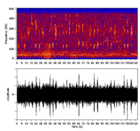Underwater acoustic communication
Underwater acoustic communication is a technique of sending and receiving message below water.[1] There are several ways of employing such communication but the most common is using hydrophones. Under water communication is difficult due to factors like multi-path propagation, time variations of the channel, small available bandwidth and strong signal attenuation, especially over long ranges. In underwater communication there are low data rates compared to terrestrial communication, since underwater communication uses acoustic waves instead of electromagnetic waves.
Contents
Types of modulation used for Underwater Acoustic Communications
Lua error in package.lua at line 80: module 'strict' not found. In general the modulation methods developed for radio communications can be adapted for underwater acoustic communications (UAC). However some of the modulation schemes are more suited to the unique underwater acoustic communication channel than others. Some of the modulation methods used for UAC are as follows:
- Frequency Shift Keying (FSK)
- Phase Shift Keying (PSK)
- Frequency Hopped Spread Spectrum (FHSS)
- Direct Sequence Spread Spectrum (DSSS)
- Frequency and Pulse Position Modulation (FPPM and PPM)
- Multiple Frequency Shift Keying (MFSK)
The following is a high level discussion on the different types of modulation and their utility to UAC.
Frequency Shift Keying as applied to UAC
FSK is the earliest form of modulation used for more advanced forms of UAC by acoustic modems. The earliest forms of UAC prior to FSK has been by percussion of different objects underwater and this method has been used to measure the speed of sound in water.
FSK usually employs two distinct frequencies to modulate data. For example Frequency F1 to indicate bit 0 and frequency F2 to indicate bit 1. Hence a binary string can be transmitted by alternating these two frequencies depending on whether it is a 0 or 1. The receiver can be as simple as having analogue matched filters to the two frequencies and a level detector to decide if a 1 or 0 was received. This is a relatively easy form of modulation and therefore used in the earliest acoustic modems. However more sophisticated Demodulator using Digital Signal Processors (DSP) can be used in the present day.
The biggest challenge FSK faces in the UAC is multi-path reflections. With multi-path (particularly in UAC) several strong reflections can be present at the receiving hydrophone and the threshold detectors become confused, thus severely limiting the use of this type of UAC to vertical channels. Adaptive equalization methods have been tried with limited success. Adaptive equalization tries to model the highly reflective UAC channel and subtract the effects from the received signal. The success has been limited due to the rapidly varying conditions and the difficulty to adapt in time.
Phase Shift Keying
(under edit)
Use of vector sensor receivers
Lua error in package.lua at line 80: module 'strict' not found. A vector sensor is capable of measuring important non-scalar components of the acoustic field such as the wave velocity, which cannot be obtained by a single scalar pressure sensor.
In recent decades, extensive research has been conducted on the theory and design of vector sensors.[2][3] Many vector sensor signal processing algorithms have been designed.[4] They have been mainly used for underwater target localization and sonar applications.
Earlier underwater acoustic communication systems have been relying on scalar sensors only, which measure the pressure of the acoustic field. Vector sensors measure the scalar and vector components of the acoustic field in a single point in space, therefore can serve as a compact multichannel receiver. This is different from the existing multichannel underwater receivers,[5][6] which are composed of spatially separated pressure-only sensors, which may result in large-size arrays.
In general, there are two types of vector sensors: inertial and gradient.[7] Inertial sensors truly measure the velocity or acceleration by responding to the acoustic medium motion, whereas gradient sensors employ a finite-difference approximation to estimate the gradients of the acoustic field such as velocity and acceleration.
In the example of vector sensor communications shown, there is one transmitter pressure transducer, shown by a black dot, whereas for reception we use a vector sensor, shown by a black square, which measures the pressure and the y and z components of the velocity. This is a 1×3 single-input multiple-output (SIMO) system. With more pressure transmitters, one can have a multiple-input multiple-output (MIMO) system also.
See also
References
- ↑ I. F. Akyildiz, D. Pompili, and T. Melodia, "Underwater Acoustic Sensor Networks: Research Challenges," Ad Hoc Networks (Elsevier), vol. 3, no. 3, pp. 257-279, March 2005.
- ↑ Proc. AIP Conf. Acoustic Particle Velocity Sensors: Design, Performance, and Applications, Mystic, CT, 1995.
- ↑ A. Nehorai and E. Paldi, “Acoustic vector-sensor array processing,” IEEE Trans. Signal Processing, vol. 42, pp. 2481-2491, 1994.
- ↑ K. T. Wong & H. Chi, "Beam Patterns of an Underwater Acoustic Vector Hydrophone Located Away from any Reflecting Boundary," IEEE Journal of Oceanic Engineering, vol. 27, no. 3, pp. 628-637, July 2002.
- ↑ T. C. Yang, “Temporal resolutions of time-reversal and passive phase conjugation for underwater acoustic communications,” IEEE J. Oceanic Eng., vol. 28, pp. 229–245, 2003.
- ↑ M. Stojanovic, J. A. Catipovic, and J. G. Proakis, “Reduced-complexity spatial and temporal processing of underwater acoustic communication signals,” J. Acoust. Soc. Am., vol. 98, pp. 961–972, 1995.
- ↑ T. B. Gabrielson, “Design problems and limitations in vector sensors,” in Proc. workshop Directional Acoustic Sensors (CD-ROM), New Port, RI, 2001.
